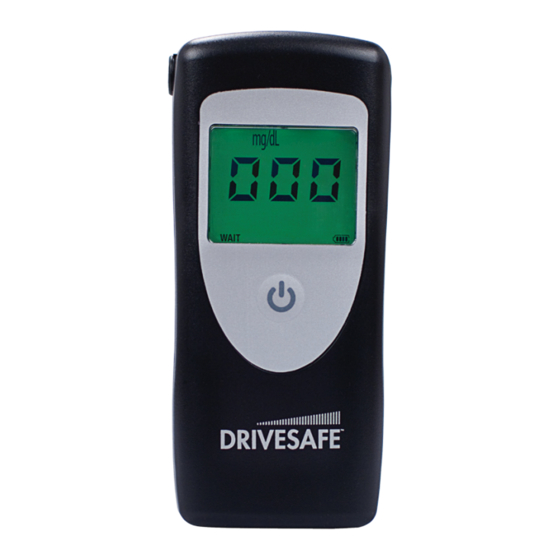
Table of Contents
Advertisement
Quick Links
Advertisement
Table of Contents

Summary of Contents for Alcohol Countermeasure Systems DRIVESAFE
- Page 1 Instruction manual...
- Page 2 Federal Communications Commission (FCC) Disclaimer Changes or modifications not expressly approved by the party responsible for compliance could void the user’s authority to operate the equipment. This device complies with Part 15 of the FCC rules. Operations are subject to the following 2 conditions: This device may not cause harmful interference.
- Page 3 ACS, ALCOHOL COUNTERMEASURE SYSTEMS, DRIVESAFE and the “Molly” are trademarks of Alcohol Countermeasure Systems (International) Inc. and are used under license. Alcohol Countermeasure Systems is the trading style of Alcohol Countermeasure Systems (International) Inc. © 2014 Alcohol Countermeasure Systems...
-
Page 5: Table Of Contents
TABLE OF CONTENTS Safety and precautions ............1 Introduction ................2 Disclaimer ................2 Getting started ................ 3 Operation ................4 Testing in normal conditions ........... 5 Testing in a cold environment ..........6 Battery power ................. 7 Battery strength indicator............7 Battery install ................ -
Page 6: Safety And Precautions
Keep magnets or mobile devices away from the tester to minimize the potential of electromagnetic interference • Make certain that the exhaust grid is not covered in any way when a breath test is being performed • Always use a mouthpiece when blowing into the tester DRIVESAFE... -
Page 7: Introduction
DISCLAIMER Sale of the DRIVESAFE personal alcohol tester is on the express condition that neither the manufacturer nor the vendor of the device shall be held responsible for the... -
Page 8: Getting Started
GETTING STARTED The DRIVESAFE personal breath alcohol tester is simple to use. The BrAC readout is provided with a digital display. With a one button operation and battery power, this tester is a perfect companion. The parts and basic features of the tester are illustrated as... -
Page 9: Operation
OPERATION The DRIVESAFE personal breath alcohol tester is easy to use and understand. Press the power button once to turn the tester on. WAIT will appear briefly during the start up sequence. READY READY will appear with a green backlight when the tester is ready for use. -
Page 10: Testing In Normal Conditions
TESTING IN NORMAL CONDITIONS NOTE: To achieve accurate results, insert a new mouthpiece each time the DRIVESAFE tester is used. Power on the tester and wait for READY to appear. Blow steadily and continuously into the mouthpiece for 5 seconds. -
Page 11: Testing In A Cold Environment
TESTING IN A COLD ENVIRONMENT • When blowing repeatedly in a cold environment (below 10 °C), condensation droplets may form inside the blow channel • When providing a test, tilt the tester as shown: • After several breath tests have been performed, blow quickly into the mouthpiece to clear any condensation NOTE: Always use a new mouthpiece when blowing into the tester. -
Page 12: Battery Power
BATTERY STRENGTH INDICATOR A battery strength indicator appears on the bottom right corner of the display when the DRIVESAFE tester is powered on. When the battery strength indicator begins to flash, the batteries require changing. If the E01 error message appears on the display, there is insufficient power to continue operation of the tester. -
Page 13: Calibration
CALIBRATION To maintain accuracy, the DRIVESAFE tester requires calibration each year from the first date of use. When calibration is due, CAL will appear on the display. If the tester is due for a calibration, contact an authorized Service Center. -
Page 14: Troubleshooting
New batteries are required; change the code E01 batteries Displays these • These errors may occur during the power error codes: up sequence and indicate that the tester requires service. Contact ACS for the E02 + E05 to E11 return procedure DRIVESAFE... - Page 15 E03 + E04 • The ambient temperature is outside the operating temperature range of 0 to 50 °C • Ensure that the device is being used within the correct temperature range. If problems persist, contact ACS • The ambient temperature is outside the operating temperature range of 20 to 30 °C during calibration •...
- Page 16 IRM-US-ENG-60-000693-A © 2014...





Need help?
Do you have a question about the DRIVESAFE and is the answer not in the manual?
Questions and answers